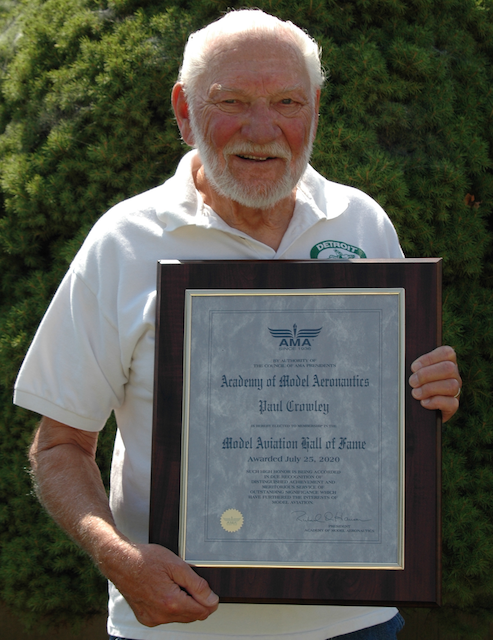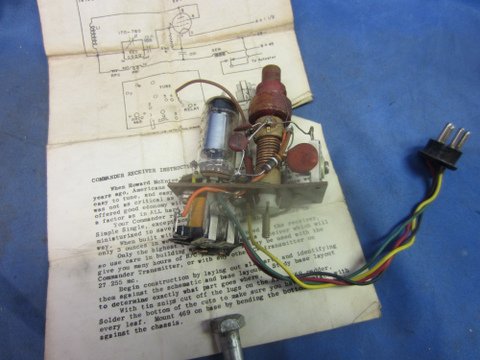 |
Flying High With Electric Power!
The Ampeer ON-LINE!
Fly the Future - Fly Electric! |
|---|
Site Table of Contents
| President: | Vice-President: | Secretary-Treasurer: |
| Ken Myers | Keith Shaw | Rick Sawicki |
| 1911 Bradshaw Ct. | 2756 Elmwood | 5089 Ledgewood Ct. W. |
| Commerce Twp., MI 48390 | Ann Arbor, MI 48104 | Commerce Twp., MI 48382 |
| (248) 669-8124 | (734) 973-6309 | (248) 685-7056 |
 | ||
| Board of Directors: | Board of Directors: | Ampeer Editor |
| David Stacer | Arthur Deane | Ken Myers |
| PO Box 75313 | 21690 Bedford Dr. | 1911 Bradshaw Ct. |
| Salem, MI 48175 | Northville, MI 48167 | Commerce Twp., MI 48390 |
| (313) 318-3288 | (248) 348-2058 | (248) 669-8124 |
| EFO Meeting, Wednesday, Jan. 13, 2021, 7:30 p.m.
Place: ZOOM, details to be sent via email | ||
| Can A Battery's IR Be Used to Know When a LiPo Pack Should Be Retired? Ken Myers and Don Patterson discuss this topic via email. | New Southeastern Michigan AMA Hall of Fame Member Joe Hass shares information about southeastern Michigan's newest AMA Hall of Fame member. |
| Advice on Powering a Sig Four Star 4-40 A discussion, via email, between Kan and Terry on selecting a power system for this plane. | Having Fun With Foam Board Jim Pollock describes how much fun he's having with hiis FT foam board planes |
| A Bit of RC History Pete Waters shares some information on a tube type receiver. | FAA Drone Registration Reminder A reminder, your registration might need to be renewed now. |
| Announcing the Upcoming January 2021 EFO Meeting Info on the upcoming EFO January meeting. | |
From Don Patterson via email I now have a Giles MK II ESR meter and it works great. I have also read a lot in the links you sent me. They sure helped. I was wondering if there is a level of ESR that suggests retiring the subject pack. I checked a 3S 2250mAh pack and got C=18, Max current 40 amps, and ESR in the mid twenties. I put this pack in a Maule M7 model and my watt meter showed 10.95 volts, 436 watts, and 40 amps at WOT. This pack was used to set up the radio but was close to fully charged. I think it was five or six years old. I shut down immediately after getting the data because in the past I smoked a motor with excessive ground running. The motor can was never more than warm but it must have been much hotter inside. Thanks and take care,
Hi Don, What we commonly call the battery's IR, a value that is assigned to a battery's internal resistance measured by various devices, is a variable number, not an absolute number. It varies by the device being used to provide the value, the temperature of the battery and the state of charge of the battery (SOC). A few years ago, when I was testing a lot of different devices that supplied IR values, including the Giles ESR meter, Revo Honesty meter and the Vollrath BattIR meter, I also found differences in the provided IR values depending on how stable the voltage was in the pack when the measurements were taken. Once a battery has been charged, it takes hours to reach a voltage stabilized state, as measured by a voltmeter. The stabilized voltage can be quite different from the voltage at the termination of the charge, once the electrons have settled down from being "so excited". Once a battery has been discharged, even slightly by one of the measuring devices, it takes hours to reach a voltage stabilized state, as measured by a voltmeter. Throw in the battery's normal self-discharge, over time, and there are now even many more variables to contend with. You didn't note whether you took the IR value before your motor test or after. Either way, you'd get slightly different values. Here is what Wayne Giles recently said about the Lipotool part of the the meter that you are using on Sept. 08, 2020 on RC Groups. During the conversation, Keith Shaw's name comes up many, many times. The Ampeer Table of Contents (TOC) page contains links to Keith Shaw's published writings, as well as much of what Keith has done since his writings first were published. "The Lipotool will only work with lipos, not LifePO cells. Strictly it is based, largely empirically, on the measurements as taken by the ESR meter as we compared many real full discharge results with the Cell IR figure taken at 250C to work out the heating calculation. This means that the predicted max safe continuous current would not over stress the cell, the criteria being excess temperature rise or sag and recovery of the cell voltage. John Julian and Mark Forsyth compared the results using some other chargers and the only ones that gave acceptable results were the FMA chargers and i - chargers. One gave slightly higher results and one lower; sorry but I can't recall which was which now. Many chargers give wildly differing results so we cannot vouch for their use in the Lipotool calculation. Wayne" Note that 25 degrees Celsius is noted in Wayne's statement. That is 77 degrees Fahrenheit. Somewhere in the instructions for at least one of the tools I was testing for comparison, I remember 22 degrees C, about 72 degrees F, being noted as the "best" temperature, and that was what I used for my comparative testing of the devices. If the same battery is tested at well above 22 degrees C, the value provided for the IR device will be lower than at 22 degrees C. If the same battery is tested at well below 22 degrees C, say 15 degrees C, or about 59 degrees Fahrenheit, the value provided by the IR device will be much higher than at 22 degrees C. To answer your question, "I was wondering if there is a level of ESR that suggests retiring the subject pack?" The simple answer is no. I have two 3S 2200mAh LiPo packs, of the same brand, that I've been using for the past three years in the same trainer-type plane. I don't believe that I ever checked their IR. They are used in a low amp draw situation. A pack is flown for two 8 minute training flights, using the timer on my transmitter, and usually not recharged at the flying field. The second pack is used in the same way. That provides 32 minutes of flight training on that trainer. I described how it is used to illustrate that the mission is always identical with the only variable, of consequence, being the wind on the day of the training flights, but because they are training flights, the wind cannot be very high for the student to fly the plane. After they are used, I put them in the LiPo Sack and measure the individual cell voltages after arriving home. After training, I usually hang around the flying field for a bit and my drive home takes 35 to 40 minutes or so. This gives the packs a good time to reach a stabilized voltage. For the past 3 years both packs have always been at approximately 3.75V to 3.8V per cell, which is what I use for a storage charge. If I were to see about 3.6V per cell, and knew that all of the flight conditions had been pretty similar to all of the pervious flight conditions, I might want to start "keeping an eye" on that pack. Yes, this is an extreme example, but if the same type of mission is flown, for the same measured time, under pretty much the same wind conditions and ambient temperature, you can see when a pack starts fading. There really is no simple answer as to when to retire a pack. All I can advise is when you notice a drop in performance, from what you normally experience, and it cannot be accounted for by environmental conditions, you might want to retire the pack to a different application or just permanently retire it. To reiterate, does just seeing a higher IR value on a device, for the same pack over time, indicate that the pack should be retired, not really, but it could be an indicator, sort of, if all readings are done under as identical conditions as possible. The point about the environmental conditions was really driven home this past fall. I was training the same students, using the same trainer plane and battery packs well into the late fall of 2020. The students had progressed to being able to fly in windier conditions. The temperature was in the low to mid-fifties, not in the 70s. The first time I got home from a training session, where these environmental conditions were flown under, and with the two 3S 2200mAh packs well rested, the resting voltage was, on average, about 3.5V to 3.6V per cell. The rest of the fall season the timer was reduced to 6.5 minutes instead of 8 minutes. I won't know until late spring, when the training season begins again, but I suspect these packs will be fine, and will continue to provide two 8 minute flights each again in the late spring, summer and early fall. Time will tell. New Southeastern Michigan AMA Hall of Fame Member
It is hard to put in to words the tremendous contributions Paul Crowley has made to the free flight community over countless decades. I remember Paul helping me, as I was a pre-teen, with an indoor free flight project over 60 years ago. I remember all the words of encouragement and great advice. He continues this generous tradition to this day. Paul's aeromodeling adventures started in grade school. He started flying competitively the early 1950s when he joined the Plymouth Aero League. He has been an active member of the Detroit Balsa Bugs since 1951 Paul attended his first NATS in1952 and has attended most since then. Some years he competed in 13 FF categories. While he tried other model aviation disciplines he always gravitated back to free flight. Any conversation with Paul reveals his depth of knowledge, willingness to share that knowledge and the incredible adventures he and his fellow modelers have enjoyed. Imagine driving across the country with fellow modelers in a 1952 Chevy Business Coupe with the rear seat removed for model aircraft storage. The removed seat was replaced with a couple of boards and a blanket across the floor for Paul's perch. Remember no air conditioning, no cell phone and only a few dollars in his pocket to attend his first NATS. He won Jr/Sr 1/2 PAA Load and returned with the $100.00 prize and a watch. Paul's career in machine design has given him the ability to create unique solutions to improve FF. Paul willingly shares his expertise with fellow free flighters. Paul was / is one of the last FAI F1B competitors to still make many of his own components. He is a real modeler. 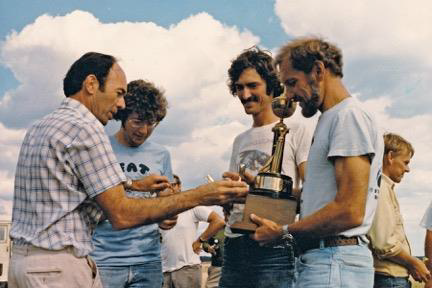
Paul winning in Wakefield in Canada in the 1970s. Paul was a member of the U.S. F1A Nordic Team in Austria in 1973 and the U.S. Wakefield Team in Hungary in 2003. He was the first winner of the prestigious America’s Cup in 1989 for F1B and has won it a total of five times. Paul was inducted into the National Free Flight Society (NFFS) Hall of Fame in 2010. Paul's designs, Happy Hooker (F1A) and the CS1 (F1D) co designed with Ed Stoll won the NFFS Model of the Year in 1974. Paul is the only winner in 2 categories in one year. Paul again had the model of the year in 1999 with his PC31 (F1B). Paul speaks fondly and eloquently of the great friendships he has with so many in the FF community. And fellow modelers speak highly of Paul. Here is an example from Bill Shailor: "At the 1990 NATS Paul and I were flying Wakefield. After the last flight Paul found me well into the chase field to congratulate me on winning, beating him by 1 second." A true gentleman. The best example of his undying commitment to the Free Flight community is his 40 years on the FAI Team Selection Committee. He was a member of the FIA team selection committee during the 1960s. He has served as part of the Contest management team for the FF World Championships at Lost Hills, CA in 1993, 2001 and 2019. He has been an AMA Leader Member and Contest Director for over 50 years. Locally, Paul has been the Treasurer of one of S. E. Michigan's Free Flight clubs, the "Balsa Bugs", for so many years that nobody remembers how long he has served. Paul has spent over 15 years working with the Science Olympiad programs taking kids who have never built anything and making progress to multi minute flights. 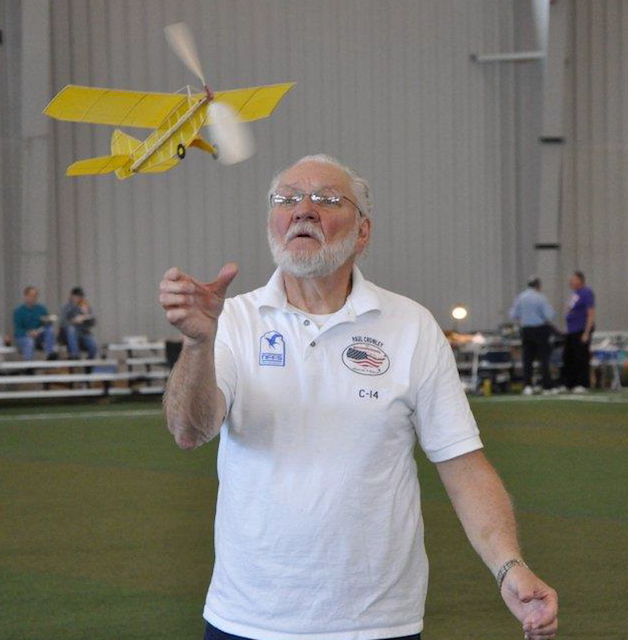
Paul is equally at home flying FF indoors. Paul helps runs the AAA Indoor Contest, known as the "Indoor Fling" that has been held in southeastern Michigan every spring for the last 30 years. He manages the AMA Events at this contest. Contestants come from around the Midwest and Canada as well as the east coast and Deep South. Paul has also served as the Contest Director at the Inter-City Meet in Muncie, IN many times over the years. For his decades of commitment and service to the Free Flight community Paul Crowley well deserves to be inducted into the AMA Model Aviation Hall of Fame for 2020. The following individuals support the nomination of Paul Crowley to the AMA Model Aviation Hall of Fame:
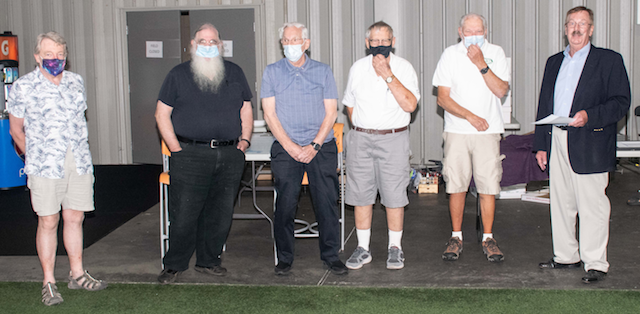
Many of southeastern Michigan's Hall of Fame at the Presentation Ceremony The photo shows many of southeastern Michigan's AMA Hall of Fame Members. Joe Hass, far right, headed up the ceremony. How many of the members can you recognize with their masks on? Unfortunately, Ken Myers was out of town on that weekend, but he sends his hearty congratulations and a warm welcome to Paul! Advice on Powering a Sig Four Star 4-40
Hi! I am a member of Tulip City Air Force RC club. I was wondering if I choose the right motor for a 40 size 4 star forty airplane. I chose a Great Planes 50-55-650 part number gpmg 4745. I plan to use a Castle 90 amp speed control out of my helicopter. Other motor suggestions like scorpion would be helpful. Notes:
We fly off long grass. Most planes have a hard time getting off this grass. I would like 3D power level. It is nice to have in order to get up and out of trouble. I fly in all types of wind and weather. I have 20 years into sport. I also fly electric helicopters up to and including 700 size. Thank you for any help.
Hi Terry, The motor you are noting is the Great Planes Rimfire .60 50-55-650 Outrunner Brushless which weighs 298g and has a stated Kv of 650. I used a Cobra C-3525/12 Brushless Motor, Kv=650 motor in my Sig 4-Star Forty. That Cobra motor weighs 253g and has a stated Kv of 650. I prop it with an APC 12x10E for about 580 watts in. Unfortunately you didn't let me know what battery you are planning to use. My electrically powered 4-Star Forty was made from the Sig kit. I did shorten the wingspan by eliminating the the outside bays on each wing panel. 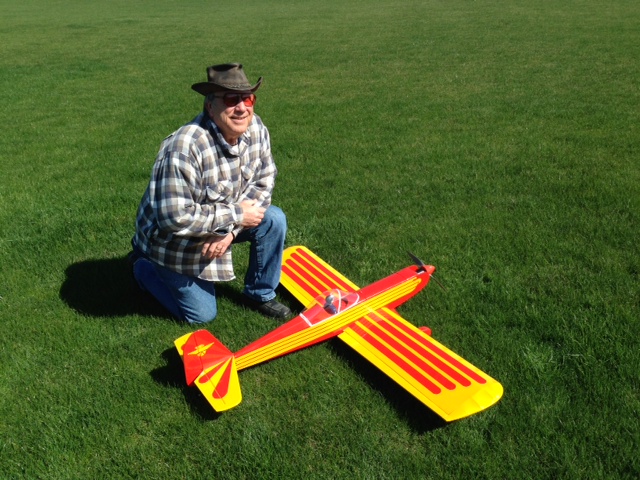 Here are my finished specifications:
 I did nothing to really lighten the kit wood or structure in any way, although I made a new firewall that fits farther forward in the fuselage. It is interesting that your plane weighs 7 lb. I believe when you say that you want a "3D power level" that you want extreme power, but not the ability to actually fly 3D, as this fly on the wing type design does not lend itself to actually flying 3D type maneuvers. I ran some numbers for the Rimfire motor that you noted with a 5S 4000mAh LiPo pack or 5S 5000mAh LiPo pack and an APC 12x8E prop. The numbers show that you could expect, at full throttle, about 950 watts in at about 50 amps with 9,900 RPM for a pitch speed of 75 mph. Using a 5S pack and an APC 12x10E, the numbers change to about 1000 watts in, at about 55 amps with 10,145 RPM for a pitch speed of 96 mph. At 7 pounds that would be about 143 watts in per pound. I also fly off grass and my 101 watts in per pound to 116 watts in per pound are more than adequate to get out of the grass easily and fly all of the typical type sport maneuvers. I think the motor you've chosen should work out well for you. If you want to use a 6S 5000mAh pack, I would recommend a Cobra C-4120/16 Brushless Motor, Kv=610. With a 6S 5000mAh pack and an APC 11x10E the numbers suggest 1280 watts in, 56 amps and 11,350 rpm for a pitch speed of 107 mph. Don't get too excited about that pitch speed. The plane will not fly that fast with its thick airfoil. At a flying weight of 7 lb., that would yield 183 watts in per pound. That is in the area required for a 3D plane. If you are converting the glow plane without changing the firewall, the pack you choose is dependent on the space you have for it. Remember you'll have to have space for the ESC in the same area and allow for airflow over the ESC and battery. Don't forget an air exit in the rear bottom of the fuselage. When I built mine, I had a lot of room up front for the battery, a 6S A123 2300mAh LiFePO4 pack, and placement of the ESC, because I placed the firewall much farther forward than for the glow motor firewall. As far as other possible motors for a Rimfire replacement, any motor that weighs about 300g and that has a stated of Kv of about 650 should substitute well. Best of luck with your 4-Star. Sincerely,
July 7, 2020 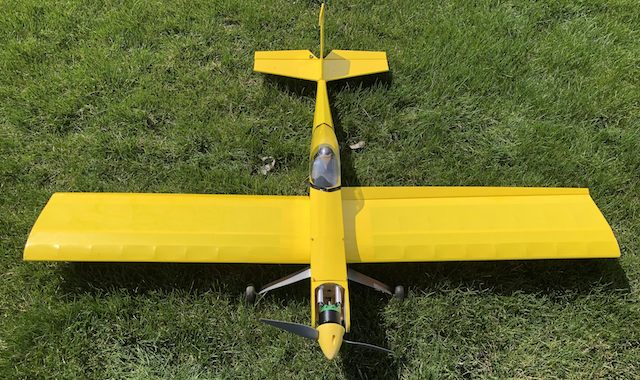 Hi Ken, I was looking through my phone pictures and saw my four star 40. I can't remember if I sent you a thanks. Thanks. It flies great. It came out at 7 pounds. I use my helicopter six cell 5000mAh battery and an old Castle Talon 90 speed control. It flies like a trainer. I added 1/2 inch to the rudder for knife edge flight. 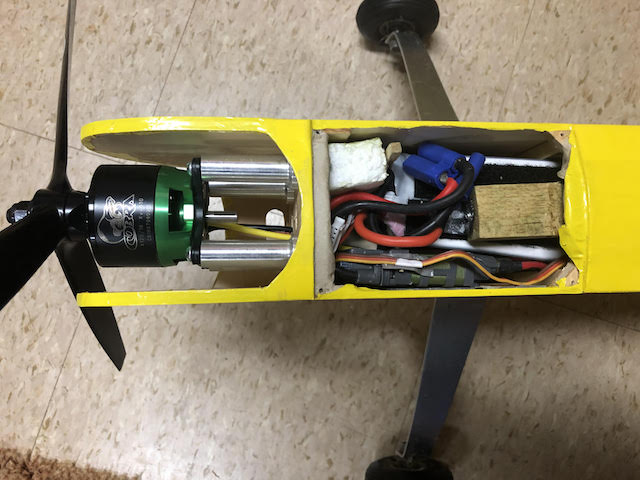 There is a CG spacer and velcro wedge so the battery doesn't move. I put together my second electric plane. It's a Vmare DHC-6 62 inch twin otter. I let the guy at Innov8tive designs choose the motors for the plane. He sold me two Cobra 2217/16, 1180Kv and 33-amp speed controllers. 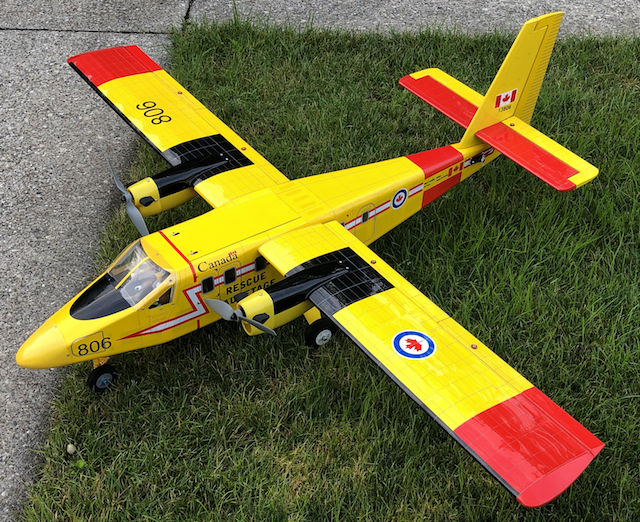 Stats on plane: The RTF weight is 5 pounds with batteries. Wing area 420 sq.in., two 11.1 volt 2200mAh 80C batteries, 10x6 props with reverse pitch on one side., 20-amp BEC. The plane will take off only with fresh cut and dry grass. It flies slow with very little climb rate. Do you think they sold me the wrong motors? I have a 1/4 inch firewall. Thanks again,
I have no idea how I missed Terry's question, but this is what my answer is. The Cobra C2217/16 Motor Propeller Data chart shows 22.2 amps, 246 watts in, 8,770 RPM and a pitch speed of about 50 mph. With a flying weight of 5 lb., that is just under 100 watts in per pound. In most cases, that should be good for this type of plane. A pitch speed of about 50 mph is also quite typical for this size and type of plane. I was not familiar with the VMAR DHC-6 Twin Otter EP ARF Kit (60.5" Wingspan), so I Googled it, as I suspected that it might have relatively tiny wheels. The photo confirmed my suspicion. Relatively small wheels don't do well from many flying field grass runways. While the numbers "look right", maybe your particular circumstances, and the way you want to fly the plane, its mission, might be outside the typical range. Did Lucien recommend the wrong power system? I'd say not, based on my personal experience. Did it end up not meeting your desires? It sounds like it, but the more planes that you select electric power systems for, the better you will bet at meeting your own expectations with your own selections. Having Fun With Foam Board
In the November 2020 issue of the Ampeer, I shared information about how much fun he is having with FliteTest foam board airframes. Here is a recent follow-up from Jim. Recent events in the world of foam board flight: I'm flying at the Clawson park that has several venues, football field, soccer field and at least two ball diamonds. I fly at the north ball field. I only fly on zero to 1 mile per hour wind days. So far the score board stepped in front of my regular size 4-channel Scout, Scout deceased. The light pole did not like my red Cub, per your design, buzzing around its light. So, smack, down came the Cub, Cub also deceased. Even with so many enemies to my airplanes, this is fun! I now have received the third and fourth box of foam board for a total of 100 sheets. Since the servos are my limiting factor, I cut, paint and have set aside several designs along with replacing the downed aircraft. Right now I'm ready to fly another red Cub, your RUA design with the FT C Power Pack. Weighing in at exactly 2 pounds AUW, is a FT Mini Trainer and the FT Mini Scout, with its picture attached. 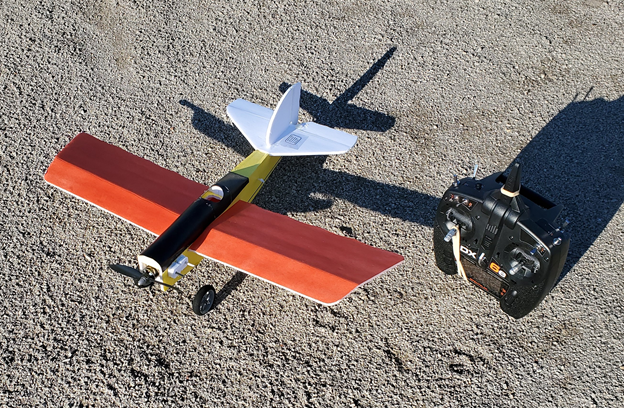 Both mini planes with the FT A Power Pack. Even with the casualties, again this is fun! Thanks for getting me started in foam boarding. Jim A Bit of RC History
How about this very early single channel receiver. It was produced by Berkeley Models as their MKIV Aerotrol receiver. It probably used several deaf aid batteries from early1950s, of 22.5 v, and 3 of them, plus a filament of 1.5v and probably a 4.5 v for the escapement. Note how large the components are. FAA Drone Registration Reminder If you live in the USA, there is a good chance you need to renew your FAA drone registration this year. I just did mine, so it might be time to do yours. Announcing the Upcoming January 2021 EFO Meeting The Wednesday, January 13 EFO meeting will be on ZOOM at 7:30 p.m. EST. EFO members, I will email the URL for the meeting close to the meeting date. Roger Wilfong is doing the hosting duties. Please bring your own snacks. To Reach Ken Myers, you can land mail to the address at the top of the page. My E-mail address is: KMyersEFO@theampeer.org |
